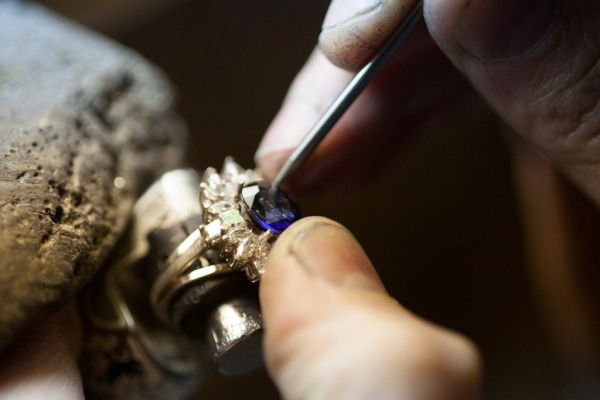
Schedule your appointment here
Setting the stone into the piece of jewelry is a form of art that requires precision and a steady hand. Here at Brax Jewelers we set the stone right in front of you! There are many variations of styles when it comes to stone setting but here are few of the fundamental ones:
Bezel Setting
The earliest known technique of attaching stones to jewelry was bezel setting. A bezel is a strip of metal bent into the shape and size of the stone and then soldered to the piece of jewelry. Then the stone is inserted into the bezel and the metal rubbed over the stone, holding it in place.
Prong Setting
Prong setting is the simplest and most common type of setting, mostly because it uses the least amount of metal to hold the stone, thus showing it off to its best advantage. Generally it is simply some number of wires, called prongs, which are of a certain size and shape, arranged in a shape and size to hold the given stone, and fixed at the base. Then a burr of the proper size, is used to cut what is known as a bearing. That bearing is cut equally into all of the prongs and at the same height above the base. Then the stone is inserted so that it goes into all of the bearings, pliers or a pusher are used to bend the prongs gently over the crown of the stone, and the tops of the prongs are clipped off with snips, filed to an even height above the stone and there you go, a newly set stone.
Channel Setting
Channel setting is a method whereby stones are suspended between two bars or strips of metal, called channels. Often when setting small stones and the bars go in a line with the design it is called channel setting. The channel is some variation of a "U" shape, with two sides and a bottom. The sides are made just a bit narrower than the width of the stone or stones to be set, and then a bearing is cut into each wall. The stone is put in place in those notches, and the metal on top is pushed down, tightening the stone in place.
Bead Setting
Bead setting is a generic term for setting a stone directly into metal using gravers, which are essentially tiny chisels. A hole is drilled directly into the metal surface, and then a ball burr is used to make a concave depression just the size of the stone.. Then the stone is inserted into that space, and the gravers are used to lift and push a tiny bit of the metal into and over the edge of the stone. Then a beading tool, which is simply a steel shaft with a concave dimple cut into the tip, is pushed onto the bit of metal, rounding and smoothing it, pushing it firmly onto the stone, and creating a "bead".
Burnish Setting
Burnish setting, also sometimes referred to as flush setting, shot setting, is similar to bead setting, but after the stone is inserted into the space, instead of using a graver to lift beads, a burnishing tool is used to push the metal all around the stone. The stone will be roughly flush with the surface, with a burnished or rubbed edge around it. The look of this is as though the metal is “butter” and the hot stone sunk into the metal.
Pricing
The costs of the stone settings all really depends on the type of setting that is being done and the shape/size of the stone(s) themselves.
Please Note: we guarantee some stones from loss for one year from date of delivery and the guarantee depends on how the stone was set, how many prongs it has and the size.
If you have anymore questions you can visit our location at 3601 Jamboree Rd, Set 15A, Newport Beach, CA 92660 or call us at (949)-250-9949
